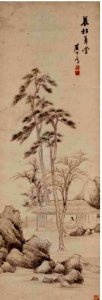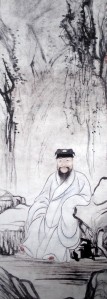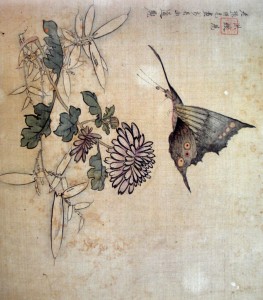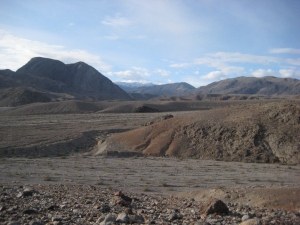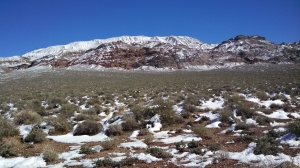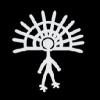What can we gain by sailing to the moon if we are not able to cross the abyss that separates us from ourselves? – Thomas Merton
Richard Wilhelm, Chinese scholar and theologian, told the story of the Rainmaker to Carl Jung while at a gathering of the Psychological Club in Zurich in the 1920s. It is a story that so impressed Jung that throughout the rest of his life he repeated it as often as he could, sometimes annoying his audience with the endless retelling. But good stories should be retold, over and over, penetrating our dim consciousness a little deeper each time. Wilhelm referred to the story as true, and although truth comes in many forms, I believe that Wilhelm’s claim is not a plea for legitimacy, but rather a call for deliberate attention.
And so the story goes:
In the ancient Chinese province of Kiaochou there was a drought so severe that many people and animals were dying. All the religious leaders attempted to solicit relief from their gods: the Catholics made processions, the Protestants said their prayers, and the Chinese fired guns to frighten away the demons of the drought. Finally, out of desperation, the town’s people called upon the Rainmaker, and from a province far away there appeared a shriveled up, old man. The old man immediately requested a small hut on the outskirts of town, where he locked himself up for three days and nights in solitude, and then, on the fourth day, it rained. In fact, it snowed at a time when snow was not expected.
Wilhelm, who was allowed to interview the Rainmaker, asked him how he made the rain, and the old man responded by exclaiming that he did not make the rain, that he was not responsible! Not satisfied with this response, Wilhelm pressed on, “Then what did you do for these three days?” And the old man explained that he had come from another province where things were in order with nature, but here, in Kiaochou, things were out of order, and so he himself was also out of order. Thus, it took three days to regain Tao and then naturally, the rain came. (Adapted from C.G. Jung, CW 14, pp. 419-420, note 211).
Upon hearing the story of the Rainmaker, like Wilhelm, I cannot resist asking what happened inside that hut for those three days, and how was the rain made? Is the Rainmaker harboring a great secret? Is he being truthful? Does he not feel the least bit responsible for making the rain? Or is this story just a quaint parable, illustrating a spiritual lesson that has no bearing on actual physical events, such as rain? In other words, is Tao only an inner, personal phenomenon, or has it any bearing on the physical world? With the severe drought conditions in California, and global warming increasing each day, these seem like important questions to answer.
And yet, the point of the Rainmaker story is precisely this: That the inner realm does touch upon the outer; that the Rainmaker’s ability to achieve Tao (whatever that means) did touch upon the clouds, the moisture, temperature, and wind, which allowed it to rain and even snow. It is a mystifying idea, indeed, because we in the modern Western world are not trained to see this interdependence. But, in a place far beyond vast oceans and time, as we see in the Rainmaker story, all things are interconnected, including that which we think of as inner and outer. As much as the ego insists on its separate singularity, ultimately, we are not our egos, imprisoned inside our skin, or inside our skulls, however you will have it. When I ask my students where the unconscious resides, most of them point to their bellies, as I do. When I ask about the ego, immediately fingers go to the head. Never does one point to a glass of water, to a tree, or to the surrounding air, even though without these things none of us would exist.
And still, I wonder, what did he do in that little hut for three days? How did he make it rain?
As far as my pea brain can fathom, to be in Tao, is to recognize our oneness with all of nature, or more so, to recognize that we are nature, that humans and nature are the same. The philosopher Alan Watts says it is a fundamental scientific truth that human organisms (or any organisms) cannot be studied or known apart from the environments in which they exist, and for this reason, ecologists speak not of organisms in environments, but of organisms—environments, indicating the inseparability between the two. We are not born into nature, Watts continues, but from it. This subtle, but significant shift in language transforms us from being aliens who invaded this planet, to full-fledged child-members born from it. And yet, although the scientist knows this, rarely does he feel it (Watts, Does it Matter, p. 90).
On the other hand, “A mystic is one who is sensibly or even sensually aware of his inseparability as an individual from the total existing universe” (Watts). The mystic and scientist both understand our inseparability from nature, yet perhaps the mystic is different because he feels it and lives it as so. The Rainmaker, obviously, felt the truth of this oneness, although it took him three days to get there. I like the idea of being a mystic-scientist, but for me, it might take three hundred years. I am still learning to identify the flowers in my backyard, or how to grow a sweet tomato.
But, on this afternoon, as I sit on the knoll over looking the canyon in Death Valley, I ponder the story of the Rainmaker and the meaning of Tao. Each year, I go into the desert for four days and nights of fasting and solitude with my friends from Lost Borders, and this is third day of uncomfortably hot weather, although it is only February. In spite of the heat, I muster up a playful spirit and pretend that I am a creosote bush inseparable from the rocky wash in which it grows, awakened by the afternoon breeze, waiting upon precious rain. I am no different than the creosote, or the rocks, or the tiny cactus that pricks my butt. And more so, even when I fail to recognize I am no different (which is most of the time), I am still no different. Which reminds me of the Zen teaching that says we are all Buddha, each and every one of us, no matter how screwed up we may feel. Even when I fail to feel my inseparability from nature, it is impossible to be separate. Perhaps, this is what the drought has to show us even if in the most painful of ways: that, no matter how separate from nature we imagine ourselves to be, we still rely on rain.
After my musings on the Death Valley knoll, I tucked myself under my tarp because clouds began rolling in from the west. And, truth be told, that night it rained! All night. I woke up early the next morning to the sweet and sexy smell of a wet desert, a cold northerly wind, and a silky blanket of snow on the peaks all around. Glory! And, I swear, I had nothing to do with it. I am not responsible.
And, of course, I later found out that rain was predicted in the forecast, and that it came as no surprise to my fellow fasters who had the acuity to read the weather report beforehand. But does the weather report discredit the Rainmaker, or does it affirm him? Or does it even matter? Science or mysticism, predicted or unexpected, we are nature. We still live by rain.
* Chinese drawings taken from the Artful Recluse Exhibition, Santa Barbara County Museum of Art
